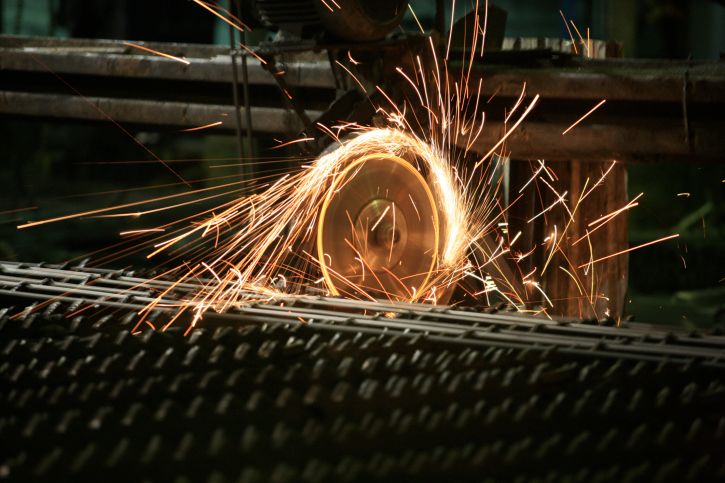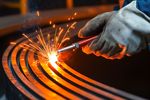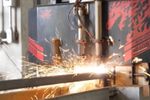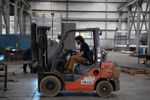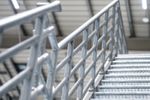We get a lot of questions about machine guards for stationary equipment, particularly regarding Occupational Safety & Health Administration (OSHA) standard CFR1910.212. OSHA publishes its standards online, yet there were over 6,000 occupational amputations in 2013 and over $6 million in penalties in 2010 for machine guard violations.
With OSHA standards so readily available, why are many manufacturers and equipment purchasers overlooking OSHA’s requirements?
Let’s start by looking at OSHA’s definition of machine guarding: a barrier that prevents entry of the operator’s hands or fingers into the point of operation. OSHA has seven enforceable machine guard standards that apply directly to stationary equipment:
- 212 — General requirements for all machines
- 213 — Woodworking machine requirements
- 215 — Abrasive wheel machinery
- 216 — Mills and calendars in the rubber and plastics industries
- 217 — Mechanical power presses
- 218 — Forging machines
- 219 — Mechanical power-transmission apparatus
Here is where things start to get complicated. These seven standards grow exponentially when you factor in the additional embedded standards — there are over 600 separate enforceable requirements within the original seven standards. Following machine guard standards becomes even more challenging when you include enforceable consensus standards referenced by OSHA.
Consensus Standards vs. OSHA Standards
OSHA understands that technology often changes faster than regulatory standards —especially in an advanced industry like manufacturing. For example, OSHA’s machine guarding standards have changed very little over the past 40 years, yet we’ve seen significant advancements in machine guarding technology such as interlocks and laser eyes.
In situations where no OHSA standard applies, OSHA’s policy is to refer to national consensus standards. OSHA provides a comprehensive definition of consensus standards, but they are basically non-proprietary, up-to-date standards that have been discussed and agreed on by a group of experts in affected industries.
When Are Machine Guard Consensus Standards Considered Law?
According to JB Titus at Control Engineering, if OSHA references a consensus standard, it is enforceable by law under “incorporation by reference.” OSHA also has the right to infer enforceable reference to non-referenced consensus standards under a “general duty clause.”
Titus provides four guiding principles when evaluating whether a consensus standard should be considered law:
- Consensus standards are not law. They are created by industry and are generally voluntary.
Titus concludes: “Simply said, to be safe . . . assume that consensus standards are legal requirements for machine safety[.]” As with anything related to the law, check with your legal department.
Understanding Machine Guard Minimum Requirements
Now that you know the regulatory requirements, how do you design your machine guard? OSHA 3067 states that machine guards must address the following six requirements at a minimum:
- Prevent contact: Hands, arms, and any other part of a worker’s body should be prevented from making contact with dangerous moving parts.
- Secure: Workers should not be able to easily remove or tamper with the safeguard. Guards and safety devices should be securely fastened and durable enough to withstand normal use.
- Protect from falling objects: Guards should prevent objects from falling into moving parts.
- Create no new hazards: A guard should not create a hazard of its own such as a shear point, a jagged edge, or an unfinished surface that can cause a laceration.
- Create no interference: Any guard that impedes a worker from performing a job quickly and comfortably is more likely to be removed by the operator.
- Allow safe lubrication: If possible, one should be able to lubricate the machine without removing any guards.
OSHA states that machine guards should address physical hazards at these locations:
- Point of operation: the physical area where work is performed, e.g., cutting, shaping, or forming. Machines that commonly require point-of-operation guarding include:
- Guillotine cutters
- Shears
- Alligator shears
- Power presses
- Milling machines
- Power saws
- Jointers
- Portable power tools
- Forming tools and calendars
- Power transmission: all components of the mechanical system that transmit energy to the part of the machine performing the work. Components include:
- Flywheels
- Pulleys
- Belts
- Connecting rods
- Couplings
- Cams
- Spindles
- Chains
- Cranks
- Gears
- Operating controls: this refers to all parts of the machine that move while the machine is working, including:
- Reciprocating parts
- Rotating parts
- In-running nip points
- Transverse moving parts
- Feed mechanisms
- Auxiliary parts
Who Is Responsible for Machine Guarding?
Everybody involved in the design and operation of a piece of equipment is responsible for the adequate installation and use of machine guards.
New equipment purchasers often assume that it’s the OEM’s responsibility to install all the necessary machine guards. In many cases, OEMs do not have process knowledge of a purchaser’s operation and have no way to ensure the equipment is being used adequately or if it was installed properly, thus putting the responsibility on the purchaser.
Even when a machine includes adequate machine guards that meet OSHA’s regulatory requirements, those guards must be continually adjusted and inspected to ensure they maintain compliance. Again, that responsibility falls on the purchaser.
Many people purchase older equipment or may opt for lower-cost equipment originally designed for residential use. While this is often accomplished without incident, always ensure your equipment is up to OSHA standards for a modern industrial environment. A machine shop or fabricator can help you retrofit equipment to meet current standards.
Your Machine Guard Experts
Whether you’re an OEM, an equipment purchaser, or someone retrofitting existing stationary equipment, there are many knowledgeable professionals who can ensure your equipment is OSHA compliant. If you need help, that’s something we can do here at Southern Metal Fabricators. We’ve been helping people fabricate top-quality machine guards since 1991 and can point you in the right direction to minimize risk by fabricating your machine guard to exact specifications.
